Making a DIY water filter can be a rewarding way to ensure you have access to clean water anywhere. This guide outlines 15 homemade DIY water filter projects that are not only practical but can also serve as engaging science experiments. With easy-to-follow instructions and a list of essential materials, each homemade water filter project is designed to help you understand the science behind water filtration.
Understanding how to make your own DIY water filter is not just about having clean water; it’s also about welcoming a sustainable lifestyle. From a simple water filter science project to more involved water filtration science experiments, these projects are perfect for anyone interested in learning more about purifying water. By the end of this guide, you’ll be eager to explore the detailed guides in the next section, which will enable you to clean water efficiently with your own DIY water filter.
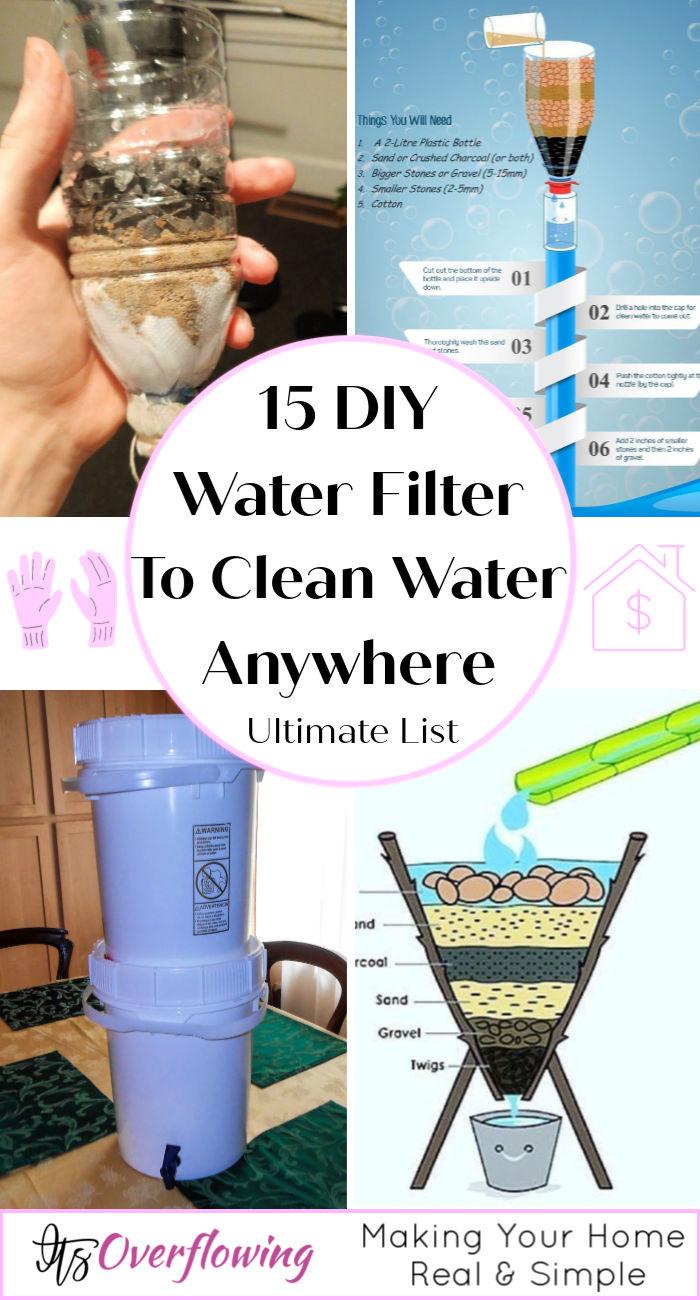
Why Make Your Own DIY Water Filter?
Making your own DIY water filter comes with a host of benefits that can significantly improve your daily life and emergency preparedness. Here’s why you should consider making your own:
- Health & Safety: By filtering your water, you remove contaminants and pathogens that could be harmful to your health. This is especially critical if you’re in a situation where the water quality is questionable.
- Cost-Effectiveness: Over time, the expense of buying bottled water or commercial water filters adds up. A DIY water filter can be made using inexpensive materials, saving you money in the long run.
- Environmental Impact: Reducing your reliance on plastic bottles by filtering your own water is an eco-friendly choice. It lessens plastic waste and the environmental toll of manufacturing and transporting bottled water.
- Education & Awareness: Making a water filter is an educational experience. It teaches you and potentially your children about the importance of clean water and how filtration works.
- Self-Sufficiency: Knowing how to make a water filter makes you more self-reliant. In emergencies or during travel, you won’t have to depend on store-bought water.
- Customization: You can tailor your DIY water filter to meet your specific needs. Whether you need to filter large volumes of water or have a portable option for camping, a homemade filter can be designed to suit your requirements.
By crafting your own water filter, you take an active role in ensuring your drinking water is clean, save money, and help protect the planet – all while equipping yourself with a valuable skill.
DIY Crochet Water Filter Cover
Making your own water filter is a fantastic step towards self-sufficiency and environmental sustainability. But why stop there? Adding a personal touch to your DIY water filter can make it not only functional but also aesthetically pleasing. Crocheting a cover for your water filter can protect the filter and make it blend seamlessly with your home decor. Here’s a simple and reliable guide to crocheting a cover for your DIY water filter, keeping it practical, yet stylish.
Materials Needed:
- Yarn: Choose a durable and washable yarn, considering the environment where your water filter will be used.
- Crochet Hook: The size will depend on your yarn’s requirements. Generally, a 4mm to 5mm hook works well for most medium-weight yarns.
- Scissors: For cutting your yarn when finished.
- Tapestry Needle: To weave in the ends of your yarn.
Basic Crochet Steps:
- Measure Your Water Filter: Start by measuring the height and circumference of your water filter. This ensures your crocheted cover will fit perfectly.
- Choose Your Pattern: For beginners, a simple single crochet stitch can be both easy and provide a tight fabric. More experienced crocheters can opt for decorative stitches or patterns.
- Start Crocheting:
- Begin with a slip knot and chain stitch enough to wrap around the circumference of the filter snugly.
- Join the chain with a slip stitch to start working in the round.
- Single crochet in each chain around, and continue working in rounds until you reach the desired height of your filter.
- For a snug fit, consider decreasing stitches towards the top if your filter tapers.
- Adding Features: If your filter has a spout or handle, you can customize the cover by leaving spaces or making buttonholes.
- Finishing Touches:
- Once you reach the desired height, finish off by cutting the yarn, leaving a long tail.
- Pull the yarn through the last loop and tighten.
- Use the tapestry needle to weave in the ends securely.
Tips for Success:
- Washability: Choose a yarn that is easy to clean, as the cover may need frequent washing.
- Tight Stitches: Ensure your stitches are tight enough to provide good coverage but not so tight that the cover becomes rigid.
- Customization: Feel free to add personal touches, like crocheting the initial of your name, decorative borders, or using yarn colors that match your decor.
Conclusion:
Crocheting a cover for your DIY water filter not only protects the filter but also allows you to infuse a bit of your personality into an everyday item. It’s a simple, creative way to enhance the practicality of your homemade water filter while also dipping your toes into the world of crochet. Happy crocheting, and enjoy your cleaner, tastier water with a touch of handmade charm!
DIY Water Filter FAQs
Making your own water filter can be a rewarding and essential skill, especially in situations where clean water is scarce. Here, we’ve compiled a list of frequently asked questions to help guide you through the process of making a DIY water filter.
What materials do I need to make a DIY water filter?
To make a basic DIY water filter, you will typically need:
- A clean plastic bottle or a similar container
- Gravel or small stones
- Sand (preferably two types: coarse and fine)
- Activated charcoal or crushed charcoal
- Clean cloth or coffee filters
- Scissors or a knife to cut the bottle
How does a DIY water filter work?
A DIY water filter cleans water by passing it through several layers that act as barriers to impurities. Here’s a simple breakdown:
- Pre-filtration: Gravel or small stones catch larger particles.
- Sand Layer: Fine and coarse sand layers help remove smaller particulate matter.
- Activated Charcoal: This layer adsorbs contaminants and impurities, including certain chemicals.
- Final Filtration: A cloth or coffee filter at the bottom acts as the final barrier to ensure clear water comes out.
Is water from a DIY water filter safe to drink?
Water filtered through a DIY system is cleaner but might not be entirely safe for drinking without further treatment. While it can remove many physical and some chemical impurities, it might not eliminate all bacteria, viruses, or harmful microorganisms. Boiling the filtered water or using purification tablets is recommended to ensure it’s safe for consumption.
How often should I replace the materials in my DIY water filter?
The lifespan of your DIY water filter materials depends on how frequently you use the filter and the quality of water being filtered. As a general guideline:
- Charcoal: Replace every 2-3 months or after filtering approximately 100 liters of water.
- Sand and Gravel: Rinse or replace every month, especially if the water being filtered is very turbid.
- Cloth or Coffee Filters: Replace these every time you clean your water filter or whenever they show signs of wear.
Can I use a DIY water filter for emergency situations?
Yes, a DIY water filter can be a valuable resource in emergency situations where access to clean water is compromised. However, remember that while it can significantly improve water quality by removing sediments and some contaminants, ensuring the water’s safety might require boiling or chemically treating the water after filtering.
How can I make my DIY water filter more effective?
To enhance the effectiveness of your DIY water filter:
- Use multiple layers of sand and charcoal.
- Ensure the charcoal is activated charcoal, known for its superior adsorption capabilities.
- Increase the height of each layer to allow for more thorough filtration.
- Regularly clean and maintain the filter, replacing materials as necessary.
Are there any eco-friendly materials I can use for a DIY water filter?
For an eco-friendly DIY water filter, focus on natural and sustainable materials:
- Use bamboo or glass containers instead of plastic bottles.
- Opt for natural cotton cloth or biodegradable coffee filters for the final filtration layer.
- Choose locally sourced sand and gravel to minimize environmental impact.
By adhering to these guidelines and frequently asked questions, you can effectively make and maintain a DIY water filter, ensuring you have access to cleaner water in a variety of situations. Remember, safety is paramount, so always take additional steps to ensure the water’s purity before consumption.
15 Homemade DIY Water Filter Projects
Discover 15 homemade DIY water filter projects to make clean, safe drinking water at home. From simple to advanced filtration techniques, start purifying water today!
1. How to Make a Water Purifier
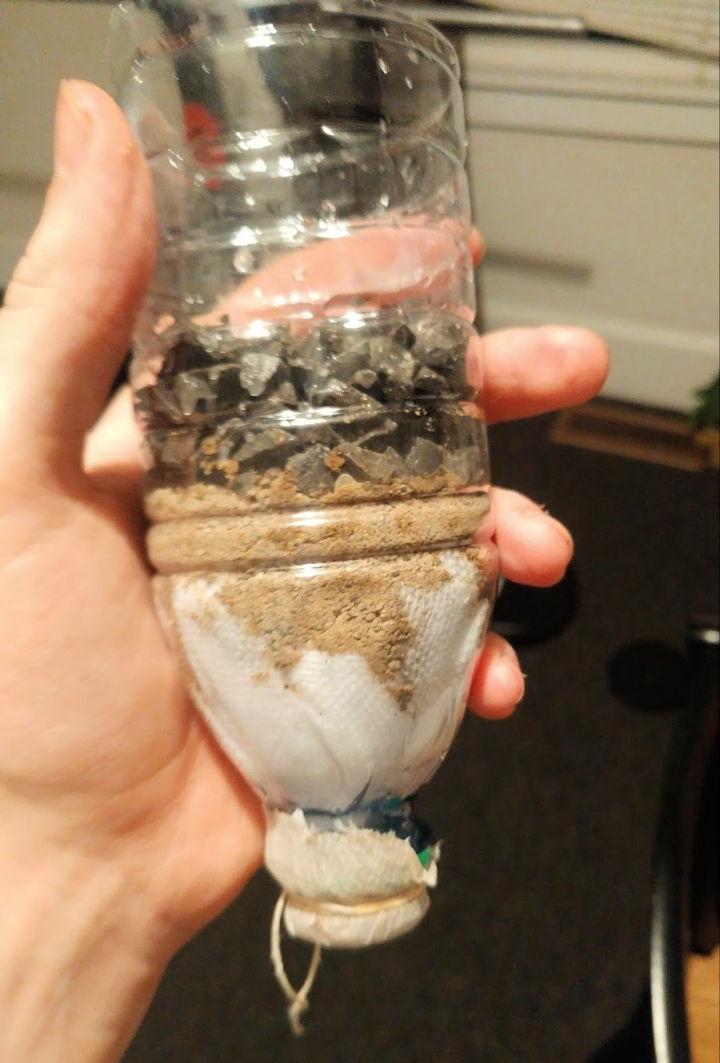
Learn how to make a homemade water purifier with everyday items through a simple guide on Steemit. The process involves a water bottle, clean small rocks, sand, gauze, a coffee filter, and a string or rubber band. Start by cutting the bottom of the bottle, layer the materials for filtration, and secure the filter with a band.
This DIY purifier is a practical skill for camping or emergency situations, ensuring access to clean water. It’s a smart way to be prepared, focusing on one of survival’s necessities. Follow these steps for a straightforward solution to water purification.
2. Inexpensive Water Filter the Bucket Berkey

Discover how to ensure safe drinking water during emergencies with the Bucket Berkey, an affordable solution from DisasterStuff.com. The Bucket Berkey is a cleverly designed water filtration system that uses two food-grade five-gallon buckets and high-quality black Berkey filters. Starting with a single filter capable of purifying around 3,000 gallons of water, the system can be expanded with additional filters to cleanse up to 12,000 gallons.
Ideal for crisis preparedness, this filter removes impurities with a 99.99999 percent effectiveness. Easy to assemble and use, the Bucket Berkey offers a cost-effective way to access clean water, with the convenience of a screw-on lid for those with dexterity issues. Trust in the Bucket Berkey for a practical and reliable addition to your emergency supplies.
3. DIY Water Filter – Step by Step Instructions

Making a DIY water filter can be a practical and educational project, and Instructables offers a comprehensive guide to help you through the process. This step-by-step tutorial is designed to equip you with the knowledge to make a filter capable of removing particulates such as dust from water.
While this system can clarify pond water, it’s important to remember that boiling is necessary to eliminate tiny organisms for safe consumption. Perfect for home science experiments or outdoor adventures, this DIY water filter project is engaging and useful for anyone interested in self-sufficiency and environmental science.
4. Make a Water Filter for Kids

Make a fun and educational experience with your kids by making a DIY water filter, as suggested by AprilAire‘s blog. This hands-on project is perfect for teaching little ones about the importance of water conservation and the principles of rain harvesting.
With simple household items like a plastic bottle, gravel, sand, activated charcoal powder, a box cutter, a rubber band, and cloth fabric, you can make a filter that demonstrates how to clean water. This activity not only engages children but also imparts valuable environmental lessons. Remember to supervise closely when using sharp tools and to keep small components away from young children. Enjoy crafting and learning together!
5. Making Your Own Water Filter

Discover how to make a homemade water filter with Instructables‘ easy-to-follow guide. Ideal for those keen on DIY projects, this instructable provides step-by-step instructions to purify dirty water using simple materials.
Perfect for educational purposes or emergency situations, it’s a practical skill that can be learned by individuals aged eight and up under parental supervision. Dive into this engaging project and equip yourself with the knowledge to ensure clean drinking water while also understanding the basics of filtration.
6. Handmade Geo Water Filter

Ensuring access to clean water is crucial for health and well-being. Geo water filters offer an innovative solution for purifying water, utilizing simple yet effective filtration techniques. Developed by Dr. N. Sai Bhaskar Reddy, these filters use layers of sand, biochar, earth balls, and gravel to treat water, making it safe for consumption. The design is straightforward, involving common materials like tin cans, charcoal, and PVC pipes, which can be easily assembled to make a functional water filtration system.
By adopting Geo water filters, you can take a significant step towards promoting sustainability and securing safe drinking water in your community. For those interested in learning more, the Slideshare presentation provides a detailed look at the filter’s design and operation. Download the PDF or view it online for free to explore the potential of Geo water filters for your water purification needs.
7. DIY Water Filter With Binchotan Charcoal
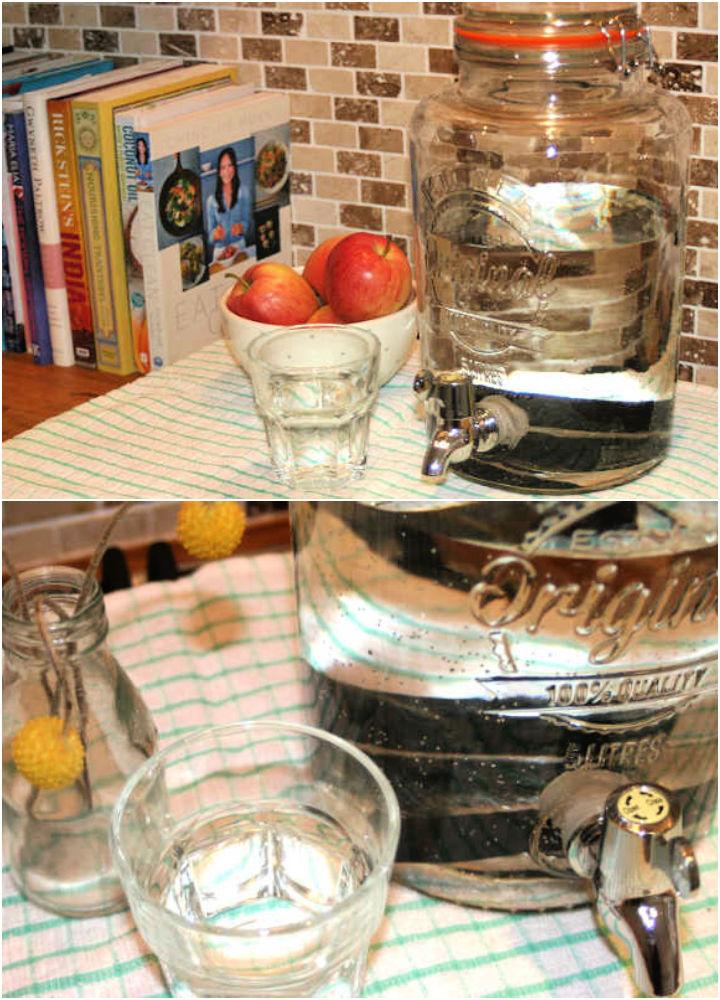
Discover how to make a homemade water filter using Binchotan charcoal with the easy and sustainable guide from One Mum & A Little Lady. This simple, four-step process transforms your tap water by reducing chlorine and adding essential minerals, improving both taste and quality.
Perfect for eco-conscious individuals, this method is cost-effective and avoids plastic waste. Binchotan charcoal, a natural purifier with a rich history, offers an accessible solution for cleaner drinking water. Learn to craft your own filter at home and enjoy the benefits of this eco-friendly alternative.
8. How to Make Your Own Water Filter

Making a homemade water filter is a practical and engaging project that you can undertake with common household items. Instructables provide a step-by-step guide to crafting a water filtration system that mimics the process used in large-scale water treatment but without the need for complex machinery. With a few simple materials like a plastic bottle, gravel, sand, and cotton balls, you can make a filter that removes impurities from water.
This DIY approach is not only educational but also demonstrates an Environmental Engineer-approved method for water purification. Remember, while this filter can improve water clarity, additional steps like multiple filtrations and boiling are necessary to ensure the water is safe for drinking. Engage in this eco-friendly project and take pride in your ability to produce cleaner water through your own homemade filter.
9. Handmade Drinking Water Filter System

Craft your own reliable homemade drinking water filter system with this straightforward guide! Perfect for ensuring clean, safe water at home, this DIY project is both a practical and empowering solution. Starting with a basic understanding of your water source and quality, you’ll learn how to assemble a multi-stage filtration system using easily accessible materials like micron filters, ceramic water filters, active carbon filters, and water softeners.
These components work together to remove impurities and bacteria and improve the taste and safety of your drinking water. Ideal for those seeking a cost-effective, hands-on approach to water purification, this guide empowers you to take control of your water quality, ensuring peace of mind and health benefits. Follow these simple steps to make a system that suits your specific needs and enjoy the satisfaction of making something both useful and essential for your home.
10. Homemade Water Filter – Science Project
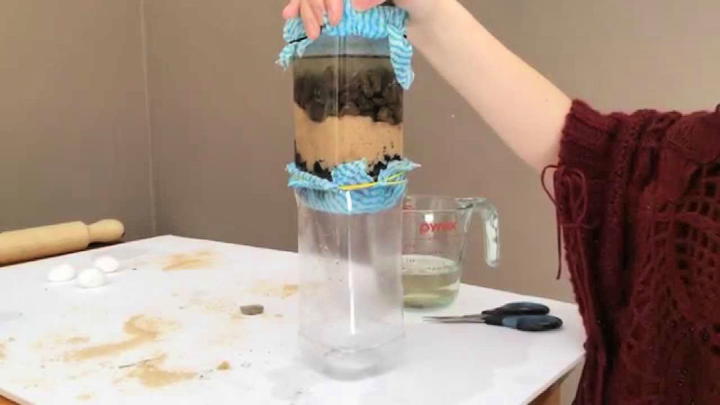
Craft a lifesaving homemade water filter with this instructive guide! Essential for emergency situations or in developing communities, this filter is simple, affordable, and effective. You’ll need two bottles, a run band, ten cotton buds, sand, crushed charcoal, small rocks, a membrane filter sheet, and a securing device. The process involves making holes and layering the filter materials for optimal purification.
This DIY filter, though not as advanced as commercial membrane filters, still delivers clear water. Including visual instructions is vital, especially for non-readers. Scale up the design for larger groups, ensuring safe, clean water for more people. Learn to make this crucial tool for clean water access today!
11. Best DIY Water Purifier Tutorial

Making a homemade water purifier can be a rewarding DIY project, offering both a practical solution for clean drinking water and a fascinating hands-on experience. YouTube’s Creative Life channel brings you a step-by-step guide on how to assemble your own water purifier using simple materials. With clear instructions, this video is perfect for anyone interested in crafting a useful device right at home.
Learn how to select the right components, understand the purification process, and gain insights into maintaining your water purifier for long-term use. Whether for educational purposes or as a cost-effective alternative, this tutorial is an engaging resource for making clean water more accessible.
12. How to Make Water Filter at Home

Making a water filter at home is a practical skill that can be incredibly useful in emergency situations or simply to understand the principles of water purification. In this instructive video on YouTube, viewers can learn step-by-step how to assemble a homemade water filter using accessible materials like charcoal, sand, and cotton cloth. The process is clearly demonstrated, making it engaging and easy to follow.
If you’re interested in DIY projects or survival techniques, this video provides a valuable lesson in ensuring access to clean water. With simple tools and natural filtering substances, you can craft a functional water filter that could be a lifesaver in times of need. Remember to always boil water after filtering to ensure it’s safe for drinking. Visit YouTube and search for “How To Make Water Filter At Home Easy Way DIY” to enhance your self-sufficiency skills today.
13. Easy and Effective Way to Make Water Filter

Learn how to make a homemade water filter with this informative YouTube video. In emergency situations or simply for educational fun, mastering the art of water filtration is a valuable skill. This guide walks you through the process step by step, highlighting the need to boil water even after filtering to ensure safety for drinking. The tutorial is designed to be simple, yet effective, using materials that are often readily available.
Whether you’re crafting a filter for actual use or as a hands-on learning experience, YouTube’s visual demonstration makes the process clear and approachable. Remember to replace the natural filtering materials like charcoal and sand periodically to maintain the filter’s effectiveness. With this easy-to-follow video, you’ll be well on your way to purifying water in no time.
14. Making a Water Filter Science Project

Discover the wonders of science at home with a 2013 Water Filter Science Project! This engaging DIY project involves making an effective water filter using common materials like a club soda bottle, gravel, fine sand, carbon, and homemade swamp water. The experiment showcases the filtering capabilities of different materials, revealing how carbon outperforms fine sand in purifying water.
Ideal for home science enthusiasts or as a school project, it demonstrates the principles of filtration in a hands-on, practical way. Watch as murky swamp water transforms into clearer water, and learn about the importance of water filtration. This project is not only educational but also a fun and creative way to explore environmental science.
15. Simple DIY High Volume Water Filter
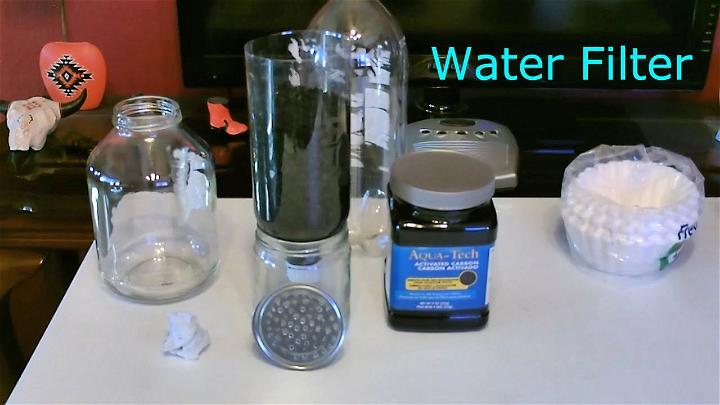
Elevate your hydration experience with a homemade high-volume water filter, crafted to transform your tap water’s taste dramatically. This DIY water filter, a blend of simplicity and efficiency, purifies your water quickly, making it crystal clear. Essential supplies include a 1-liter bottle, a small screen, activated carbon, and a metal or plastic diffuser. The process involves cutting the bottle, fitting the screen into the cap, and adding activated carbon.
The diffuser then evenly spreads water over the filtering materials. Suitable for daily use, this filter is effective in removing sediment and chlorine, offering a noticeable improvement in water taste. Easy to maintain, it ensures a lasting supply of pure water, filtering a gallon in just over three minutes. Dive into the world of homemade filtration and enjoy cleaner, tastier water every day!
Conclusion:
In conclusion, 15 homemade DIY water filter projects offer an ingenious solution for accessing clean water anywhere, whether for travel, emergency situations, or educational purposes like a water filter science project or water filtration science experiment. Crafting your own DIY water filter not only empowers you with self-reliance but also enables you to customize your water filtration needs, including making an eco-friendly choice with materials.
Additionally, integrating a DIY crochet water filter cover adds a personalized touch to your project while protecting your filter. Remember, safety is paramount, so ensure your DIY water filter provides water that is safe to drink and keep abreast of when to replace the materials. The projects highlighted not only underscore the importance of clean water but also the satisfaction and efficiency of making a solution with your own hands.
